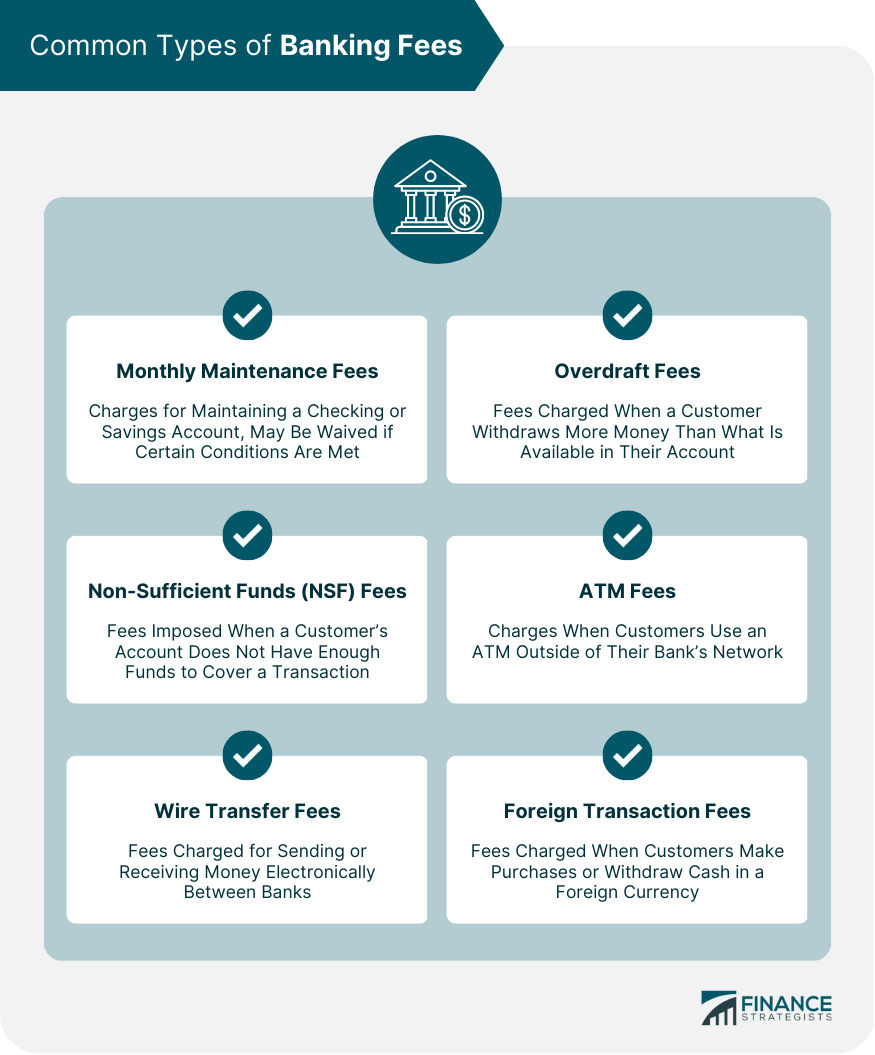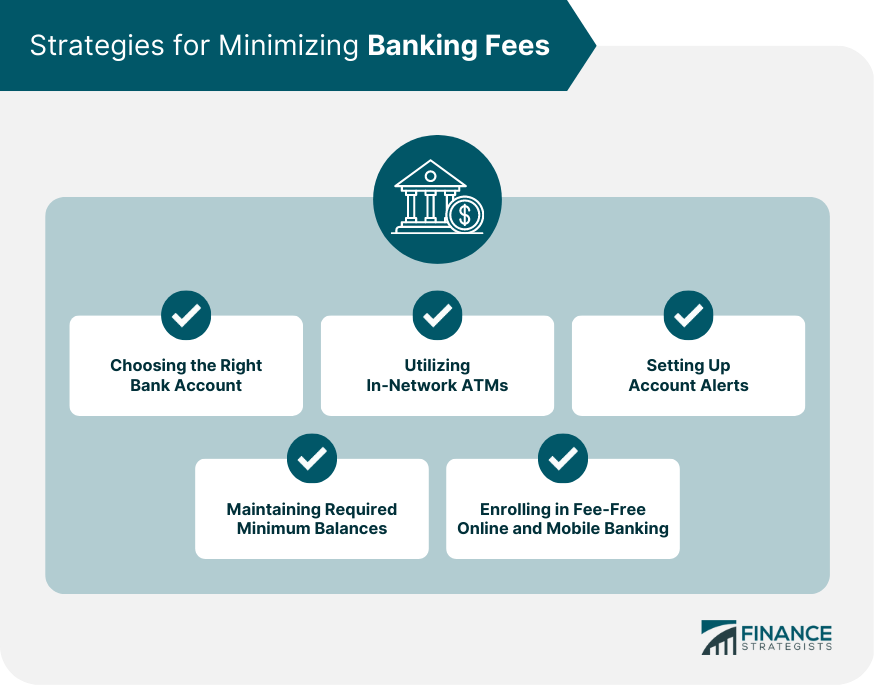Banking fees are charges imposed by banks and other financial institutions for services provided to customers. These fees serve as a source of revenue for banks and help cover operational costs. Banking fees enable financial institutions to maintain and improve their infrastructure, technology, and customer service. They also help banks comply with regulations and manage risks associated with their services. Banks, credit unions, and other financial institutions charge fees for various services. These fees may differ depending on the type and size of the institution, as well as the specific services offered. There are numerous banking fees that customers may encounter, ranging from maintenance fees to transaction-related charges. Here is a list of common fees that customers should be aware of. Monthly maintenance fees are charges imposed by banks to cover the costs of maintaining checking and savings accounts. These fees may be waived if certain conditions, such as maintaining a minimum balance or having a direct deposit, are met. Overdraft fees occur when a customer withdraws more money than what is available in their account. Banks charge these fees to cover the cost of providing temporary credit to the customer. Non-Sufficient Funds (NSF) fees are charged when a customer's account does not have enough funds to cover a transaction, such as a check or an automatic payment. These fees are imposed to discourage customers from making transactions without sufficient funds. ATM fees are charged by banks when customers use an ATM outside of their bank's network. These fees compensate banks for the costs associated with providing ATM access and maintaining the machines. Wire transfer fees are charged for sending or receiving money electronically between banks. These fees cover the cost of processing and securely transferring funds between financial institutions. Foreign transaction fees are charged when customers make purchases or withdraw cash in a foreign currency. These fees help banks cover the costs associated with currency conversion and international transactions. Banking fees can have significant financial implications for consumers. This section discusses the burden on low-income individuals, incentives for maintaining minimum balances, and the importance of comparing fee structures across banks. Banking fees disproportionately affect low-income individuals who may struggle to maintain minimum balances or avoid overdrafts. These fees can create a cycle of debt and limit access to essential banking services. Banks often waive certain fees, such as monthly maintenance fees, for customers who maintain a minimum balance. This incentivizes customers to keep more money in their accounts, which can help banks generate more revenue through loans and investments. Different banks have varying fee structures, making it essential for consumers to compare fees before opening an account. By choosing a bank with lower fees, customers can save money and reduce the overall financial impact of banking fees. There are several ways customers can minimize or avoid banking fees. This section discusses selecting the right bank account, utilizing in-network ATMs, setting up account alerts, maintaining minimum balances, and enrolling in fee-free online and mobile banking. Customers can minimize banking fees by carefully selecting a bank account with low or no fees. Online banks and credit unions often offer competitive fee structures and may have more attractive options compared to traditional banks. By using in-network ATMs, customers can avoid ATM fees charged by their banks for out-of-network withdrawals. Many banks provide a list of in-network ATMs or offer a mobile app to help customers locate fee-free machines. Customers can set up account alerts to receive notifications about low balances or potential overdrafts. These alerts can help prevent overdraft and NSF fees by allowing customers to transfer funds or adjust transactions before fees are incurred. By maintaining the required minimum balances in their accounts, customers can avoid monthly maintenance fees. This may require careful budgeting and planning to ensure that account balances remain above the minimum threshold. Many banks offer fee-free online and mobile banking services, which can help customers avoid fees associated with paper statements, teller transactions, and other in-person services. By embracing digital banking, customers can save money and enjoy the convenience of managing their finances from anywhere. Banking fees are subject to various government regulations, industry standards, and consumer protection laws. This section provides an overview of these policies and their implications for customers. Financial institutions must adhere to government regulations that govern banking fees, such as disclosure requirements and caps on certain fees. These regulations aim to protect consumers and promote transparency in the banking industry. Banks are encouraged to follow industry standards and best practices related to banking fees. This may include offering clear fee disclosures, providing account alerts, and ensuring that customers have access to in-network ATMs. Consumer protection laws, such as the Truth in Savings Act and the Electronic Fund Transfer Act, aim to protect customers from unfair and deceptive banking practices. These laws require financial institutions to provide clear information about fees and other account terms to help customers make informed decisions. The banking industry is continually evolving, and future trends may impact banking fees. This section discusses the emergence of digital banks, increasing transparency, and innovations in fee structures. As digital banks become more prevalent, traditional banks may face increased competition, potentially leading to reduced fees. Digital banks often have lower overhead costs and can pass these savings onto customers through lower or no fees. As consumers demand greater transparency in banking fees, banks are likely to provide clearer fee disclosures and comparison tools. This increased transparency may help customers make more informed decisions and encourage banks to offer more competitive fee structures. The banking industry may see innovations in fee structures as banks look for new ways to generate revenue and differentiate themselves from competitors. This could include tiered fee structures, bundled services, or customizable account features that allow customers to choose the services they need. Understanding banking fees is crucial for consumers to make informed financial decisions and minimize the impact of these charges on their finances. By comparing fee structures, utilizing strategies to minimize fees, and staying informed about industry trends and regulations, customers can effectively manage their banking costs and take control of their financial well-being.Definition of Banking Fees
Common Types of Banking Fees
Monthly Maintenance Fees
Overdraft Fees
Non-Sufficient Funds (NSF) Fees
ATM Fees
Wire Transfer Fees
Foreign Transaction Fees

Impact of Banking Fees on Consumers
Financial Burden for Low-Income Individuals
Incentives for Maintaining Minimum Balances
Comparison of Fee Structures Across Banks
Strategies for Minimizing Banking Fees
Choosing the Right Bank Account
Utilizing In-Network ATMs
Setting Up Account Alerts
Maintaining Required Minimum Balances
Enrolling in Fee-Free Online and Mobile Banking

Regulations and Policies Governing Banking Fees
Government Regulations
Industry Standards and Best Practices
Consumer Protection Laws
Final Thoughts
Banking Fees FAQs
Banking fees are charges that banks or financial institutions levy on various services they offer, such as account maintenance, transactions, or ATM usage.
Common types of banking fees include overdraft fees, monthly maintenance fees, ATM fees, wire transfer fees, foreign transaction fees, and late payment fees.
Banking fees can significantly impact your finances if you are not aware of them. These fees can add up and reduce your account balance, resulting in overdrafts, insufficient funds, or even account closure.
Yes, you can minimize banking fees by reviewing your account terms and conditions, opting for fee-free accounts, avoiding unnecessary transactions, using bank ATMs, and negotiating with your bank.
Not all banking fees are avoidable, but you can take steps to reduce them. Some fees may be waived if you meet certain requirements, such as maintaining a minimum account balance or setting up direct deposits.
True Tamplin is a published author, public speaker, CEO of UpDigital, and founder of Finance Strategists.
True is a Certified Educator in Personal Finance (CEPF®), author of The Handy Financial Ratios Guide, a member of the Society for Advancing Business Editing and Writing, contributes to his financial education site, Finance Strategists, and has spoken to various financial communities such as the CFA Institute, as well as university students like his Alma mater, Biola University, where he received a bachelor of science in business and data analytics.
To learn more about True, visit his personal website or view his author profiles on Amazon, Nasdaq and Forbes.















